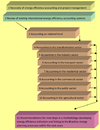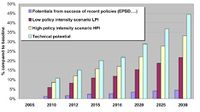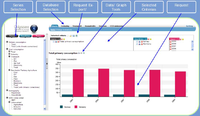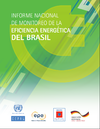Knowledge fuels change
For over a decade, Energypedia has shared free, reliable energy expertise with the world.
We’re now facing a serious funding gap.
Help keep this platform alive — your donation, big or small, truly matters!
Thank you for your support
Difference between revisions of "Energy Efficiency Planning Instruments in Brazil"
***** (***** | *****) m (→Overview) |
***** (***** | *****) m (Ranisha moved page Energy efficiency planning instruments in Brazil to Energy Efficiency Planning Instruments in Brazil without leaving a redirect) |
Revision as of 13:56, 25 November 2015
Overview
This article informs about the selection and implementation process of different energy efficiency planning instruments in Brazil. The Brazilian Energy Planning Authority EPE (port. Empresa de Pesquisa Energética) was thereby supported by Deutsche Gesellschaft für Internationale Zusammenarbeit (GIZ) GmbH[1].
Introduction
Energy efficiency policies still play a marginal role in Brazil. Since the beginning of the century, however, the country is gradually building a regulatory framework to develop such policies, accompanied by energy efficiency monitoring to improve future planning. In order to understand the quality and quantities of energy efficiency and to stimulate further progress in efficient use of energy, EPE aimed on a refinement and completion of their modelling and forecast methodologies. Therefore, different energy efficiency planning instruments, belonging to bottom-up and top-down approaches, were discussed before choosing the right ones for the Brazilian context, harnessing lessons-learned from other countries. The data generated by these instruments should lead to the establishment of a Brazilian energy efficiency data accounting system.
Conception / Preparation
Within the framework of designing complementary energy efficiency policies in Brazil, the first step consisted in the elaboration of a baseline study to identify the state of the art and the promotion of knowledge exchange between Brazil and other countries on best practices applying energy efficiency planning instruments and policies abroad. This chapter informs about the knowledge sharing process that afterwards led to the development of specific, demand-oriented energy efficiency planning instruments for Brazil.
State of the art of energy efficiency in Brazil and proposals for improvement - Estado da arte da eficiência energética no Brasil e propostas de melhorias (2009)
This baseline-study gives an overview about the state of the art of energy efficiency policies and monitoring systems in Brazil. The study concludes that since beginning of the century,many energy efficiency policies have been introduced and some actions have been carried on by the authorities to implement comprehensive accounting systems to monitor the energy savings induced by the policies. However, improving the monitoring system would lead to better understanding on how to complement the policy mix.
Assessment of the current situation and state of the art of energy efficiency in Brazil (2009)
This study gives an overview on international instruments to evaluate the energy efficiency levels in a country and formats to collect and organize data for the accounting system. The authors make proposals of energy efficiency indicators for each Brazilian sector (transport, industry etc.) by applying a “top-down-approach“. Recommendations target the creation of a comprehensive monitoring database with those indicators and use it as an energy efficiency planning instrument in Brazil.
Bottom-up methodologies and their possible application in Brazil (2010)
The objective of this work was to provide an overview and insight on “bottom-up approaches“ (methods and data requirements) as energy efficiency planning instruments. It points out key elements like benefit-cost perspectives, net costs of energy saved and cost-potential curves. Moreover, it informs about data acquisition procedures and proposes a possible roadmap to introduce cost potential curves as an energy efficiency planning instrument in Brazil.
Energy Efficiency Policy in Europe (2010)
This study gives an overview on energy efficiency policies applied in Europe. With its focus being limited to end-use energy efficiency, it first gives a comprehensive overview of the European policy and market developments. Furthermore, it analyses the various types of policies implemented in the European countries and outlines good practices, e.g. energy efficiency policies are more effectively if they are bundled in policy packages. However, designing adequate policies requires a comprehensive monitoring system for energy efficiency.
Indicators
A proven methodology for measuring energy efficiency on the macro level is the use of Energy Efficiency Indicators calculated with a “top down approach”. Indicators relate the energy consumption in a sector with a physical value (e.g. electricity consumption in MWh per build square meter m2 in the service sector) or with an economical value (e.g. primary energy consumption in MWh per GDP in Reais R$ for a national economy). The indicators can be macro economical or for a specific sector. For representing tendencies, an index can be calculated, thereby an indicator is calculated for a baseline year (represents 100%) and the value of the same indicator for the following years is given in relation to the value of the baseline year (variation in %). With this approach, it can be monitored if a policy introduced in a specific year in one sector has an impact on the energy consumption (% variation). The “top down approach” refers to the use of macro data, e.g. the energy consumption of the whole household sector, population in a country, GDP etc.
EPE has implemented an indicator data basis for Brazil with the purpose to monitor and evaluate the effectiveness of Brazilian energy efficiency policies and to develop complementary policy measures.
Planning of indicators
Training on Energy Efficiency Indicators for EPE - report (2011)
The training on energy efficiency indicators by EPE in September 2011 aimed to strengthen the capacity building of EPE staff in order to facilitate the implementation, completion and utilization of a Brazilian database on energy efficiency indicators. Therefore, European experiences with the ODYSSEE project[2] on energy efficiency indicators were harnessed. Due to the role of the EPE dealing with indicators and its involvement on energy demand projections, the training also established the link between indicators, as measured from statistics, and their use in energy demand forecasting models.
Introduction to indicators and ODYSSEE - training on indicators (2011)
This presentation gives an overview on quantitative energy efficiency targets, the necessity of indicators and there implementation and establishment in the EU through the ODYSSEE project. It shows that monitoring is crucial in order to accompany and reevaluate constantly the results of energy efficiency policies.
Energy efficiency indicators for transport - training on indicators (2011)
ODYSSEE indicators for the transport sector were developed in accordance with basic transport indicators as shown in this presentation. Calculation modes for specific indicators for cars or road transport for goods are explained and the importance of the modal split for energy efficiency is shown. The appendix shows data sources for the transport sector and thereby how data for the monitoring of indicators can be gathered.
Energy efficiency indicators in industry - training on indicators (2011)
The training on indicators for the industrial sector suggests to categorize the different industrial branches in order to analyze their specific energy efficiency demands and potentials. The importance of benchmarking in order to structure indicators for the industry is explained. The second part of the training treated about indices of energy efficiency progress at industry level (ODEX) and methods for measuring savings and impacts in this sector.
Households and service sector indicators and surveys - training on indicators (2011)
In the household and service sector, ODYSEE indicators were developed in accordance with measurements of the energy consumption for heating, water heating, electrical appliances and lighting. Further to the development of indicators, the training shows how surveys are conducted and evaluated to obtain data from this sector, as well as how climatic variances are included in energy efficiency calculations.
Structure of the ODYSSEE database - training on indicators (2011)
The ODYSSEE database is based on an Excel template for data processing. Thereby, it guarantees transparency and reinforces control of inputs. This presentation shows how data is organized in the template, how the visualization of indicators works and where key indicators of ODYSEE are disseminated on an interactive web database (free access).
Implementation of indicators
After completion of the training measures on indicators, the next steps on the way to an international compatible database for energy efficiency indicators in Brazil were the implementation of a template for input data, oriented on ODYSSEE template and adapted to the special Brazilian requirements. A strategy to development to improve the data gathering was another topic. The Enerdata consultancy commissioned by GIZ developed this template and held a workshop with EPE staff to identify and enhance critical points of data acquisition.
Methodological guidelines for ODYSSEE data template for Brazil - ANNEX 1 - (2012)
This document provides a methodological guideline for the data necessary for the calculation of energy efficiency indicators for a data template to be used by EPE, closely oriented on the ODYSSEE template.
Adaptations to BRAZIL of the ODYSSEE data template by EPE and Enerdata - ANNEX 2 - (2012)
This study presents and comments some changes, inclusions and exclusions done in the ODYSSEE data template to adapt it to the Brazilian particularities. In the introduction, general changes to the template are indicated and also data adaptations for all sectors. Part of the changes aim at adapting the template to the BEN (Energy Balance for Brazil) particularly in terms of subdivisions in sectors.
Training on European experiences with data gathering for indicators in different sectors
Industry sector data and surveys - training on indicators (2012)
This presentation shows the main sources for data on activities and energy consumption in the industrial sector per branch. It presents a case study from France, the survey methodology of EACI (Executive Agency for Competitiveness and Innovation).
Example of household survey case of Norway - training on indicators (2012)
In Norway, energy efficiency data from the household sector is gathered by the annual Survey of Consumer Expenditure, which recently added questions about energy use relating cooking, heating and fuels used in the households.
Services data and surveys - training on indicators (2012)
In the EU countries, data for energy efficiency data in the service sector is composed from the following sources: surveys, modeling, administrative sources and auditing, measuring and metering. Analyzing the deficits of data gathering for this sector shows that few countries in the EU are providing data about energy consumption by branch and end-use. This presentation gives an overview on best practices and service sector survey methodologies of EU countries such as France, Germany, Sweden and Denmark.
Transport sector data and surveys - training on indicators (2012)
Indicators for transport rely on data about the stock of vehicles, their specific consumption, technical specifications and patterns of use. The presentation shows case studies explaining data gathering in France, Tunisia and Ireland.
ODYSSEE indicators and policies - training on indicators (2012)
This presentation shows how energy efficiency indicators can be used to support policy making and monitor results of energy efficiency policies. They serve to set benchmarks, to justify the public budget and help to understand when and why targets are not met.
Publication of indicators
Technical note about the introduction of energy efficiency indicators: Energy consumption in Brazil (2014) -
NOTA TÉCNICA DEA 10/14: Consumo de Energia no Brasil
This technical note aims on disseminate the results obtained by the energy efficiency indicators database in Brazil. Thereby, these results should have an impact on future energy planning.
Monitoring the energy efficiency of Brazil - National Report - Informe nacional de monitoreo de la eficiencia energética del Brasil (2015)
In order to disseminate the results of the application of energy efficiency indicators for Brazil in Latin America, EPE published this report together with CEPAL, the Economic Commission for Latin America and the Caribbean. The cooperation was based on the idea of harmonizing the Brazilian database with other initiatives in Latin America.
References
- ↑ As a federal enterprise, the Deutsche Gesellschaft für Internationale Zusammenarbeit (GIZ) GmbH supports the federal German government in achieving its international cooperation objectives. Together, Brazil and Germany face global challenges such as preserving biodiversity and fighting climate change. The German Cooperation for Sustainable Development therefore operates primarily in two areas: Protection and sustainable management of Rain Forests as well as Renewable Energies and Energy Efficiency. Within the cooperation with the Brazilian partners GIZ provides advice on strategy development, support for developing management and cooperation structures, as well as technical expertise
- ↑ More information about ODYSSEE: http://www.odyssee-mure.eu/ (Retrieved on 13th of October 2015)
























